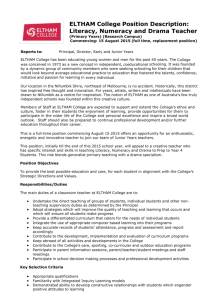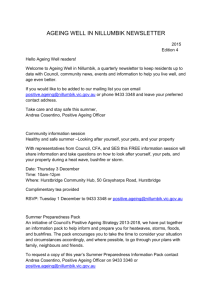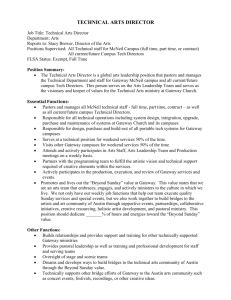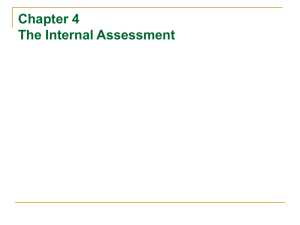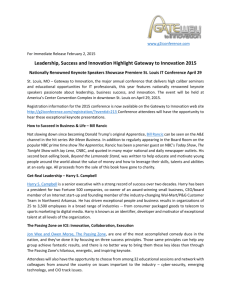Eltham Gateway Design Guidelines
advertisement
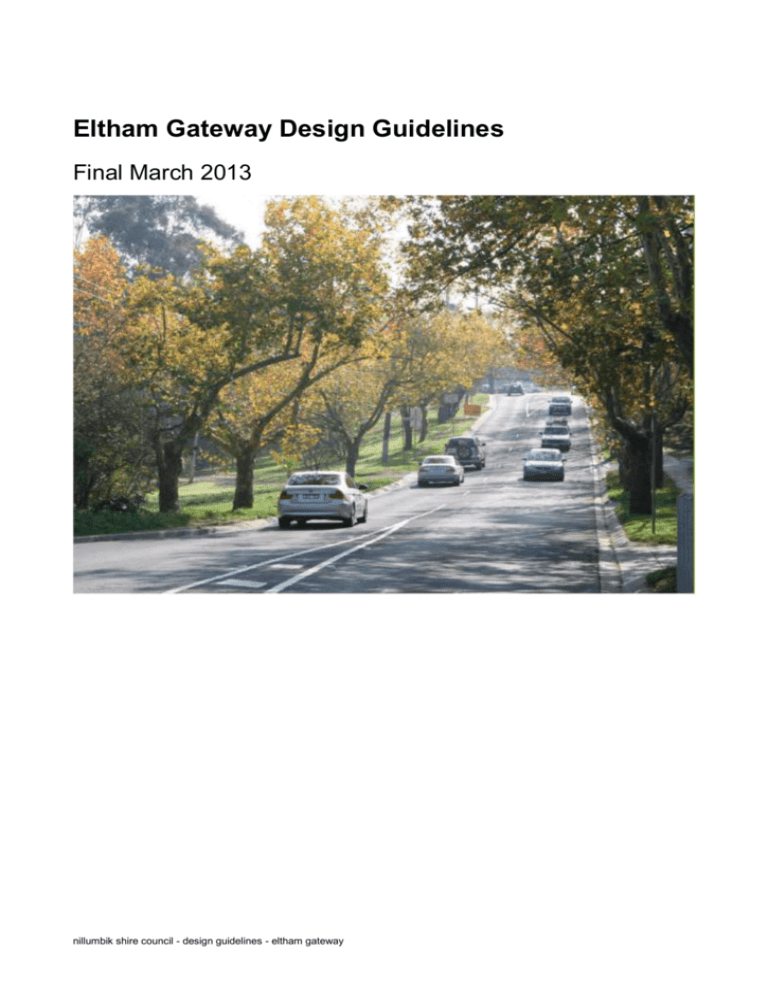
Eltham Gateway Design Guidelines Final March 2013 nillumbik shire council - design guidelines - eltham gateway Eltham Gateway Design Guidelines 1.1 The Eltham Gateway The Eltham Gateway is a corridor of land along Main Road, which leads to the southern approach to the Eltham Major Activity Centre. The Gateway is typified by interesting and historical architecture nestled amongst extensive vegetation cover. The map indicates the extent of the Eltham Gateway and its relevant properties. The purpose of the urban design guidelines is to guide new development within the Eltham Gateway to support the preferred character for the area, which is as follows: The Gateway will provide a strong sense of arrival into Eltham and exemplify the natural and historical qualities of the township. The strong presence of indigenous and exotic vegetation, particularly canopy trees, both within the public and private realms will reinforce the vegetation dominated character of the area. Buildings will be sited and designed to integrate with the landscape setting and be sympathetic to the historical context. These urban design guidelines are intended to be used by anyone who is interested or involved in the planning and development process and the use of premises (landowners, designers, developers, occupiers, community, Council etc) to better understand how to suitably respond to local planning policies and design controls associated with the Eltham Gateway. A Design and Development Overlay (DDO1) applies to land within the Eltham Gateway, which sets regulations and development expectations to realise the preferred character of the area. Use this design guideline document to assist in the design phases for all new development within the Eltham Gateway precinct. nillumbik shire council - design guidelines - eltham gateway nillumbik shire council - design guidelines - eltham gateway 1.2 The Existing Character Existing Quality and Tones The following provides a summary and illustration of key existing textural qualities available within the Eltham Gateway: Natural and textured materials Subdued earthy colours Traditional domestic materials Dense indigenous and exotic vegetation - inspiration for hues and colours Existing Form and Pattern The following provides a summary and illustration of key typical building and landscape features within the Eltham Gateway: Heritage presence Low domestic scale and generous spacing Pitched, gabled and angled roofs Simple façade compositions and detailing Sloped topography Extensive vegetation cover 1.3 The Design Guidelines Structure These design guidelines are intended to ensure that new development provides an appropriate and sympathetic response to the preferred character of the Eltham Gateway. nillumbik shire council - design guidelines - eltham gateway The Eltham Gateway Design Guidelines is structured around 4 themes including the following: 1. Site Design (SD): Covers aspects which relate to the existing qualities of the land such as vegetation, topography and land form, streetscape character and pattern and development configuration. 2. Building Design (BD): Focuses on the design on the building. It provides guidance on the desired scale, building form, appearance, and material treatments. 3. Building Context (BC): Pays attention to the landscape and access areas around the development. It also provides guidance on ancillary features including signage and lighting. 4. Public Domain (PD): Provides information on how public places such as streets and civic spaces should be designed to enhance the local character of the area. Within each theme, a set of objectives, guidelines and design directions provide advice on good design measures that should be considered in all new developments within the Eltham Gateway. nillumbik shire council - design guidelines - eltham gateway 1 Site Design Guidelines SD01: Site Analysis Objective: Ensure the building design is site and context responsive. Design Guidelines & Directions: New applications should provide statements/ detail in regards to: Site location, orientation and key views to and from the site Proximity to services and open space Existing vegetation Existing heritage attributes or if abutting any heritage buildings Response to the design guidelines SD02: Vegetation Objective: Protect, retain and enhance significant vegetation and landscape that contributes to the character of the Eltham Gateway. Design Guidelines & Directions: a. Lots affected by a Significant Landscape Overlay 7 (shown on the planning scheme map as SLO7) must comply with the Landscape Character Objectives and Permit Requirements as stated in the schedule. b. Maximise building setbacks from Main Road to allow effective landscape zones. Such zones should retain and protect established vegetation. North of Mount Pleasant Road: Generally 8 – 10m in width. South of Mount Pleasant Road: Generally 10 – 12m in width. c. Site development to minimise removal of vegetation, particularly established canopy trees and vegetation along property boundaries. d. Land proximate to the Diamond Creek waterway should enhance the valley floor with indigenous vegetation and robust understorey growth. nillumbik shire council - design guidelines - eltham gateway SD03: Topography Objective: Ensure development integrates with the surrounding landscape and minimises disturbance to the natural landform. Design Guidelines & Directions: a. Site development to correspond with the natural contours of the land. On heavily sloped sites, building should use split level design to minimise earth works and reduce visual impact, b. Access driveways should also follow the contour profile and avoid significant excavation works. c. Minimise the use and reliance on retaining walls and batter walls. If required, they should appear inconspicuous (no greater than 500mm high) and constructed with natural materials such as stone, timber and textured materials. d. Locate buildings and structures away from local ridge lines and prominent hill tops. nillumbik shire council - design guidelines - eltham gateway e. Buildings should appear as a recessive element in the bush garden valley, especially from key views available from Main Road. SD04: Streetscape Pattern Objective: Promote attractive and coherent streetscapes that emphasise a generous landscaped quality between buildings. Design Guidelines & Directions: a. Apply consistent front setbacks with neighbouring buildings. b. Development located on street corners should have regard to prevailing setback distances to both streets. nillumbik shire council - design guidelines - eltham gateway c. Apply generous spacing from abutting buildings to allow for a belt of landscaping along the sides and rear. Generally, the minimum depth for side and rear planting should be in the order of 3-5m wide to include a range of vegetation types and canopy planting. d. Site development to respect major view lines from public viewing locations. New buildings should be sited to minimise interruption of views to the Diamond Creek valley. e. Development on large sites should emulate the subdivision pattern of the streetscape. Incorporate articulated facades with building reliefs to correspond with the prevailing pattern. f. Building envelopes should be proportionate in scale to surrounding buildings. Buildings of high intensity are encouraged to occur within the Eltham Major Activity Centre. SD05: Functionality Objective: Establish safe, functional, practical developments that contribute to the urban structure of the Gateway. nillumbik shire council - design guidelines - eltham gateway Design Guidelines & Directions: a. Vehicle access points should be separate from pedestrian access points. b. Avoid functional impacts on public spaces and pedestrian footpaths. c. Entry and exit points should be adequately signed and include sufficient lighting. d. Street façade and ground floor internal layout should allow direct visual and physical access to adjoining public realm/street. e. Locate private open spaces and key living/ active areas to face a northerly and/ or easterly direction. f. Footpaths leading to the building entrance should be: no greater than 1.4m in width constructed of quality materials complementary to the bush garden character of the area such as compacted crushed rock and aggregate finishes. nillumbik shire council - design guidelines - eltham gateway SD06: Sustainability Objective: Establish energy efficient development appropriate to local conditions and climate. Design Guidelines & Directions: a. Investigate opportunities for solar heating/ energy harvesting and rain water collections. b. Locate equipment to be away from public view or integrate with the building design. c. Rain water tanks should be positioned to the rear of the building or placed underground. d. Position windows to allow for natural cross ventilation. e. Provide external shading devices to control heat gain. f. Incorporate extended eaves to allow winter sun and restrict summer sun. g. Encourage the use of movement sensitive light sensors when the building is not occupied to lower energy use. \ nillumbik shire council - design guidelines - eltham gateway Building Design Guidelines BD01: Building Height & Form Objectives: Promote building scales consistent with the Design Development Overlay 1 – The Eltham Gateway. Ensure buildings are discrete in form and incorporate interesting spaces and projections rather than present as solid bulky structures. Design Guidelines & Directions: a. Development should reflect a scale compatible with the prevailing 1 & 2 storey domestic buildings within the Eltham Gateway b. The maximum wall height (excluding gable end walls) of a building should be no more than 6.0 metres. c. The upper levels of developments should be recessed and appear visibly less than the lower level. This will assist in terms of overshadowing, overlooking and visual bulk. d. Apply sufficient side setbacks to upper levels to allow for canopy planting which can screen a two storey wall from neighbouring properties and oblique views from the street. e. Buildings should not dominate above surrounding canopy trees and unreasonably interrupt the prevailing tree line. nillumbik shire council - design guidelines - eltham gateway nillumbik shire council - design guidelines - eltham gateway BD02: Building Style & Façade Composition Objectives: Ensure that development is designed and sited to maintain the preferred character of the Gateway. Promote contemporary buildings that complement the bush garden character and historical buildings through interpretive expression and material use. Encourage development which is sympathetic to the timber or mud brick, gabled architecture that is part of the Eltham Gateway character. Design Guidelines & Directions: a. Buildings should be contemporary in style and incorporate simple building elements. Excessive decoration and historical reproduction styles (e.g. Mock Victorian and Tudor) are strongly discouraged. b. Use techniques such as interpreting and simplifying the prevailing building characteristics available in the area. As an example, incorporate angles that relate to the gabled architecture present within the Gateway and use common materials that suit surrounding landscape and local building stock. c. Position front entrance to face the primary street. d. Buildings located on corner sites should address both streets and provide ‘multisided’ façade treatments. Apply a feature architectural element that ‘wraps’ around the corner of the building. e. Incorporate design features such as porticos, verandahs and/ or porches into the façade to visually break up long walls and elevations. Such elements should project at least 1.5m from the principal façade wall. f. Incorporate treatments that lighten the building form such as glazed balconies, transparent balustrading and windows/openings. Ensure the front façade does not present as a solid blank wall. g. Incorporate strong sense of vertical and horizontal divisions in the façade to break up expansive areas of walling. Such divisions should be strategically applied to correspond with key lines available within the streetscape (such as roof parapets, façade elements, and subdivision pattern). h. Apply varying material treatments to exposed side elevations. Use at least 2 different material types combined with building recesses and projections to ensure the side walls are attractive and well articulated. i. Service related areas and equipment should be located away from public view or adequately screened. nillumbik shire council - design guidelines - eltham gateway nillumbik shire council - design guidelines - eltham gateway BD03: Roof Form Objective: Promote roof styles that are respectful to heritage and residential buildings in the Eltham gateway and establish a consistent ‘roofscape’ image Design Guidelines & Directions: a. Roof should appear simple in design without fussy detail and decoration. b. Incorporate pitched and gable ended roofs. c. Avoid curved and flat roof forms as they do not reflect the prevailing style within Eltham Gateway. Skillion roofs may be considered but must respond to the angles and lines available in the street and adjoining buildings. d. Apply extended eaves (of at least 450mm in depth) to the roof design. This will enhance the presentation of the building and assist in controlling sun light penetration. e. Use materials on roofs and car ports that are matte in finish and low in reflectivity. nillumbik shire council - design guidelines - eltham gateway BD04: Materials, Colours, Hues & Texture Objective: Encourage a diverse range of material and colours that complement the urban and landscape setting of the Gateway Design Guidelines & Directions: a. Use a range of local earth coloured, muted tones as the building’s primary base colour. b. Draw upon the surrounding landscape as an inspiration for the colour palette selection on external walls. Seek to harmoniously blend with the bush garden environment with the application of local earth coloured tones, for example – subdued whites, greys, greens, browns and dark orange. c. Use a mix of materials, textures and finishes including lightweight cladding, timber, render, non masonry sheeting, glazing, stone, brick, mud-brick and iron roofing. d. Avoid large expanses of uninterrupted walls (breadth of 5m) of a singular surface treatment. e. Ensure a balanced use of ‘heavy’ and ‘light’ weight treatments. Walls detailed with natural stone and masonry such as brickwork (including rendered), rammed earth or mud brick will create an appearance of mass and weight. Such wall treatments should be offset with features that offer a light weight appearance such as verandahs, pergolas, and balanced areas of glazing. nillumbik shire council - design guidelines - eltham gateway nillumbik shire council - design guidelines - eltham gateway Building Context Guidelines BC01: Access & Parking Objectives: Ensure driveways, garages and carports do not dominate the streetscape image. Ensure the design of parking and access areas is safe, practical and attractive. Design Guidelines & Directions: a. The number of vehicle crossovers should be limited to 1 on standard size lots. On larger sites and consolidated lots, rationalise the number vehicle entry points. On a corner site, locate the vehicle entry point to be accessed from the side street. b. Locating car parking in front of the building will be strongly discouraged. Position parking areas to the sides or rear of the building combined with extensive screen landscaping. c. Garages and carports should be a secondary element to the main façade of the building. Apply a setback of at least 1.5m behind the main building line except if extensive excavation will be required. d. Open car parking areas and access ways should be paved in permeable surfaces. Use materials that reflect a ‘textured’ quality such as compacted earth, stone, crushed rock, gravel, granitic sand etc. to merge with the bush garden setting. e. Plant a combination of indigenous canopy trees and shrubs to provide shade in car parks and screen parking areas from adjoining properties and public spaces. nillumbik shire council - design guidelines - eltham gateway nillumbik shire council - design guidelines - eltham gateway BC02: Boundary Treatments - Landscape Objective: Reinforce the vegetation dominated view of private allotments when viewed from the street. Design Guidelines & Directions: a. Apply a ‘layered’ landscaping regime which incorporates canopy trees, shrub planting and low lying plants. b. Use plant/ tree species that are indigenous to the local area, especially on sites that adjoin public parkland or are in close proximity to waterways. c. Planting of exotic species should be used sparingly and only as a landscape feature. Plant extensive indigenous and indigenous vegetation to the sides and rear of the building. d. Minimise broad areas of lawn to reduce reliance on water use. As an alternative, plant indigenous and drought tolerant grasses that will complement the surrounding bush garden setting. nillumbik shire council - design guidelines - eltham gateway BC03: Boundary Treatments - Fencing Objective: Encourage front fences that offer a sense of openness from the street. Design Guidelines & Directions: a. Seek to define the front boundary through landscaping treatments and edge planting. b. Front fencing is discouraged. But if required, they should be: Low in height (maximum of 1.2m); Visually transparent (which incorporates regular spacing between pickets and rails); and Constructed with light weight materials, such as timber and steel. c. Side fences should not begin in front of the main building façade. d. Side, rear or screen fences should not exceed 1.8m in height. e. For retaining walls design, refer to guidelines SD04 – Topography. nillumbik shire council - design guidelines - eltham gateway BC04: Signage Objective: Ensure signage will be minimised and integrated into the design of the building façade and landscape setting. Design Guidelines & Directions: a. All signage should be in accordance with Nillumbik Shire Council’s Clause 22.09 – Signage Policy. b. Signage on non-residential uses should be unobtrusive and proportionate to the building façade. Signage should be located below the roof eave. c. Where a non-residential development contains a number of tenancies, signs should be consolidated and limited to 1 panel board, avoiding the excessive visual clutter. d. The total advertisement area to each premise for a business identification sign must not exceed 3m2. e. Avoid use of primary colours on signage and opt instead for subdued tones. f. Avoid painted/ fixed signage on the building windows. g. Illuminated, neon lighting, billboards or animated advertising and signage are prohibited within the Eltham Gateway and will continue to be strongly discouraged in the future should State Government signage provisions be varied. h. Integrate signage and lighting with the building form and facade. i. Roadway signage should not interrupt pedestrian flow or affect road safety. Private free standing street signage (‘A” frame) should be no larger than 1m in height, 800mm in width and 500mm in depth. nillumbik shire council - design guidelines - eltham gateway BC05: External Lighting Objective: Ensure lighting of development creates a safe environment and does not detract from the bush garden character of the area. Design Guidelines & Directions: a. Light spillage from signage and lighting for car parks should be contained to within property lines. Landscaping should not be relied upon to prevent light spillage into the public realm. b. The brightness of lighting should be restricted to a level that protects the amenity of the area. c. Overhead lights must not be higher than the building height and must be baffled to prevent light spilling into adjoining properties d. The design of lights and equipment should be simple in style and discrete in profile. nillumbik shire council - design guidelines - eltham gateway e. The colour of light post and heads should be of a tone that will blend with the bush garden landscape or the exterior of the building. nillumbik shire council - design guidelines - eltham gateway Public Domain Guidelines PD01: Access, Footpaths & Parking Objectives: Ensure equitable access is provided for all modes of transport including public transport, vehicles, cyclists and pedestrians. Ensure the design of crossovers, footpaths and parking areas do not detract from the bush garden landscape character of Eltham Gateway. Design Guidelines & Directions: a. Removal of existing canopy trees when locating new vehicle crossovers will be strongly discouraged. b. New vehicle crossovers to Main Road should be constructed with materials that will complement the bush garden landscape such as exposed aggregate concrete of earthy tones. Seek to progressively upgrade existing standard concrete cross-overs over time, to ensure a consistent treatment. c. Shared paths should be a minimum of 2.5 metres in width, clearly marked and preferably constructed with asphalt or finished concrete. d. Whilst paths should be direct, the alignment of paths should not be rigid and formal. Meandering and informal pathways are encouraged to flow around existing landscapes and lead to key views and vantage points. e. Where existing informal paths occur, these indicate preferred pedestrian movement lines. Investigate such paths for formalisation with a clearly defined footpath made with permeable materials. f. Locating open car parking areas to front Main Road will be strongly discouraged. nillumbik shire council - design guidelines - eltham gateway nillumbik shire council - design guidelines - eltham gateway PD02: Landscape – Soft & Hard Objective: Protect and enhance significant cultural and landscape features that contribute to the gateway experience. Ensure the public environment establishes a strong sense of arrival into Eltham through high quality landscaping treatments. Design Guidelines & Directions: a. Enhance and retain existing canopy trees, especially established indigenous and exotic avenue street trees along Main Road. b. New landscaping should have regard to existing valued views to the creek valley. c. The selection of street trees should be indigenous to the area except when replacing culturally significant plantings such as the plane trees (Platanus orientalis) along Main Road. d. The location of new street trees should be within road verges and should generally be no more than 10-15 metres apart. e. Landscaping should be designed to minimise the visual impact of roadside parking with low-lying shrubs and trees in tree pits where possible. f. Reinforce a consistent bush garden themed avenue planting with a common selection of species available in the area. g. Utilise the slope of the land and incorporate kerb diverts to direct water run-off to landscaped areas or key water collection points. h. The bush garden character and landscape should provide cues for any sculptural elements such as public art. Public art is encouraged at strategic locations and should embrace the historical context and aesthetic quality of the land. i. Use naturally found objects such as stone, fallen timber, existing vegetation, etc for sculptural gateway elements. nillumbik shire council - design guidelines - eltham gateway nillumbik shire council - design guidelines - eltham gateway PD03: Street Furniture, Lighting & Signage Objective: Ensure the signage, lighting and street infrastructure do not dominate the streetscape and visual clutter is minimised. Design Guidelines & Directions: a. Ensure bus stops and street furniture such as bins, seating and shelters are consistent in design which fit in with the bush garden character of the gateway and Council policy. b. Seek to progressively upgrade street furniture which reflects a robust appearance and utilises complementary materials and colours. c. While currently street lighting is predominantly attached to power pole masks, over time seek to improve and update light heads and poles that will be complementary to the landscaped gateway setting. d. Lights should be simple in appearance. Mock heritage or ornate features are to be avoided. e. Update and enhance existing signage to clearly demarcate public open spaces, community facilities and the Eltham Town centre entry. New signage should be contemporary and incorporate materials familiar to the area such as timber, steel and stone. f. Public signage should be compatible in design, scale, material, style, and colour with the existing bush garden qualities and with the overall streetscape. g. Where possible, progressively reduce kerbside infrastructure to minimise visual clutter. For example, investigate opportunities to relocate powerlines and rationalise bus stops and road signage where appropriate. nillumbik shire council - design guidelines - eltham gateway nillumbik shire council - design guidelines - eltham gateway
